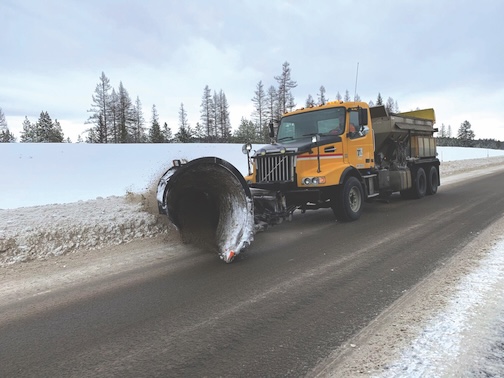BACK IN THE SADDLE
Published 12:00 am Wednesday, August 31, 2005

- Hamley's is now owned by partners Parley Pearce, right, and formerLa Grande Wendy's owner Blair Woodfield. It remains in its original location at 30 S.E. Court in Pendleton. (Submitted photo).
Bill Rautenstrauch
Trending
Staff Writer
PENDLETON A Western equipment and apparel store with a history stretching back a century is on the comeback trail.
Hamley and Company, a cowboy and cowgirl emporium most famous for its saddles, re-opens under new management and celebrates its centennial just after Labor Day.
Trending
The store, now owned by partners Parley Pearce and former La Grande Wendy’s owner Blair Woodfield, remains in its original location at 30 S.E. Court.
It looks more like its old self, every day. It’s had a complete makeover, with an eye toward bringing back the original ambiance.
"All the interior brick was plastered over," said Justin Pearce, Parley’s son and the man in charge of of a massive reconstruction effort. "Getting back down to the brick was a serious job."
The reborn store includes over 10,000 square feet of retail space, and a conference and event facility on an upper level.
The decor features bronze accents including monument-sized Western sculptures by Austin Barton of Wallowa County, David Manuel of La Grande and Buck McCain of Tuscon, Ariz.
"They fit the Hamley theme and tradition nicely," Pearce said of the sculptures which include Barton’s "Attitude Adjustment," Manuel’s "Rolling Thunder" and McCain’s "The Cowboy.
Hamley’s was once a world-famous cowboy outfitter, though in recent years it has operated as a shadow of its former self.
The business has its genesis during America’s pioneer era, a time when tens of thousands of men and women uprooted themselves and traveled west, looking for a bright new future.
Among them were brothers John and Henry Hamley of Minnesota. They left home in 1883, bound for Dakota Territory.
In a town called Ashton, they opened a harness and saddle shop. After some success there, they moved their business to Idaho.
Henry died in 1894. About 10 years later, John Hamley and his son Lester moved on to Pendleton, a bustling agricultural center and future home of the Pendleton Round-Up.
"They were innovative businessmen. They established themselves in downtown Pendleton as quality saddlemakers," Parley Pearce said.
Opened in Pendleton in 1905, the business grew quickly. Hamley’s branched out into chaps, spurs, bridles and bits, hats, boots, scarves virtually anything a ranch hand’s heart might desire.
"It became a destination for cowboys all over the West," Parley Pearce said. He noted that Hamley’s also developed a catalog and sold by mail order.
For cowhands everywhere, the Hamley label, on any item of equipment or clothing, spoke of quality.
But most of all, Hamley’s was in the business of saddles. Its contributions to the art and science of sitting on a horse are enduring ones.
Hamley’s main claim to fame is the Wade saddle tree, which was developed for legendary Wallowa County horseman Tom Dorrance and named for Dorrance’s close friend, Clifford Wade.
"It was and still is one of the most popular saddle trees in all America," Parley Pearce said.
John Hamley was a founder of the Pendleton Round-Up, today one of the premiere professional rodeos in the country.
Catering to the rodeo crowd, his company designed and made trophy saddles that are collector items today.
And that wasn’t all.
In 1919, the Pendleton, Cheyenne, Walla Walla and Boise rodeo committees consulted with Hamley’s on development of the so-called "Committee" or "Association’ saddle" that became standard equipment for professional bronc riders.
The company stayed in the Hamley family until about 1980, when David Hamley, last in the line of successors, retired and sold out to a Portland businessman.
Parley Pearce said the new owner was in over his head from the beginning.
"He didn’t know the business, so he found a cowboy who ran it until the mid-1990s," Parley Pearce said.
Pearce said Dave Edwards, another Portland investor, later acquired the building. For a time, Honda Corp. had partial control of the Hamley trademark.
By 2,000, Hamley’s was still selling Western apparel and some other cowboy-related items, but had quit producing its famous saddles.
It still did business in the three-story building at Southeast First and Court streets, but it wasn’t the place to shop it once was.
Pearce, for one, dreamed of restoring it to its former glory. In the 1990s, he made a couple of unsuccessful attempts to buy the business.
Pearce wanted title to the building and ownership of the Hamley trademark, too. But there were problems with acquisition of those things.
For a while, Pearce gave up. Later, however, he and Edwards worked those issues out.
"We got the building and the trademark under one ownership, and assured that the Hamley name would stay in Pendleton," Pearce said.
Pearce and longtime business partner Woodfield, both of Walla Walla, acquired title to the building in early 2004. The trademark and copyright issues were resolved later.
Justin Pearce, a graduate of Washington State’s MBA program, has ramrodded more than 65 workers in the remodeling project.
Parley Pearce said he is proud of the work his son has accomplished in the historic building.
"Justin’s done a wonderful job and we’re very pleased," he said. "He’s been involved in every aspect, and his work speaks for itself."
Since Hamley’s will again produce saddles, the remodel included the building of a shop on the first floor.
Veteran saddlemaker Monte Beckman will be in charge of that area, said Parley Pearce.
"He’s a very capable artist and craftsman," he said.
Not all saddles will be made on premises. Many will be commissioned and made elsewhere according to Hamley specifications.
Pearce said the new company is re-establishing a relationship with another old local business, Pendleton Woolen Mills.
That concern, founded in Pendleton in 1909, is headquartered in Portland now. It still produces limited quantities of merchandise in Pendleton, however.
Historically, Hamley’s and the woolen mills have worked together, marketing each other’s wares.









